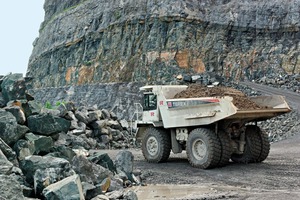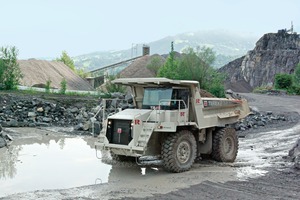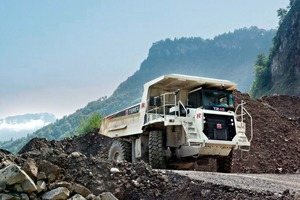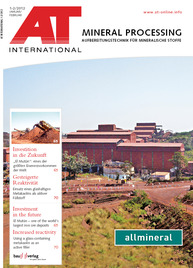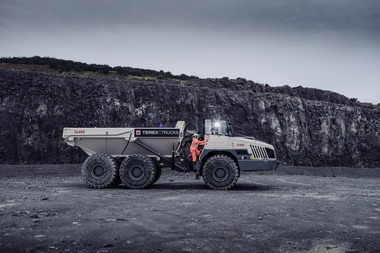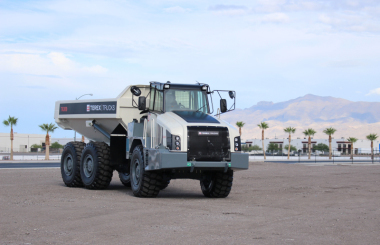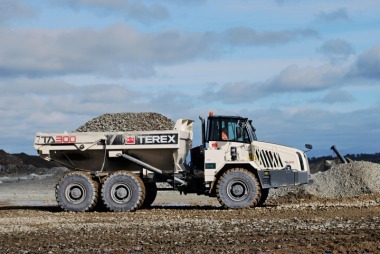High performance – low consumption
The Rhomberg Group, a renowned, internationally active building group headquartered in Vorarlberg, runs the raw material centre Hohenems located only about 18 km from Bregenz. This quarry is one of the most important raw material suppliers in the lower Rhine valley. The quarried and processed material ensures the long-term supply of the region with stone, asphalt and concrete.
Among their comprehensive fleet of machines and vehicles are two Terex TR45 (Figs. 1 and 2) rigid frame dump trucks. These heavy trucks are driven by powerful yet economical 6- cylinder turbo diesel engines (Fig. 3) with a gross output of 392 kW (525 HP) at 2000 rpm. The vehicles with a weight of 37 t offer a maximum payload of 41 t. The capacity of the body amounts to 26 m³. The decision of the Rhomberg Group to purchase equipment from Terex was based on the performance and economic efficiency, in addition to the product quality. For cost-conscious entrepreneurs, the fuel consumption is an essential factor in the overall operation costs of a commercial vehicle. Both Terex TR45 dumpers were convincing in every respect in the harsh conditions of quarry operation.
Glauconitic sandstone and Seewen limestone of the Gault formation are quarried in the Hohenems quarry. After blasting or excavation, the TR45 transport, the rock – about 150 000 t annually – to the crushing plant and then the sorted rock to stockpiles or storage boxes. Up to 1500 t per day and up to 3000 t per week are transported by the Terex bodies. A distance of up to 2000 m is covered per load. Every TR45 in the Rhomberg quarry is in use approx. 950 hours per year. The average fuel consumption per operating hour amounts to only 14 to 16 l. The valuable lumps, which are suitable as armour stones, are sorted out and are transported by the Terex dumpers to an onsite depot from where they will be further supplied later. The extracted Seewen limestone is directly discharged by the heavy trucks into the crushing plant. Depending on the grain size, the material is processed there for use as crushed stone or double-broken and double-screened chippings for asphalt surfacing.
The maximum ground adhesion of the Terex TR45 is achieved by the double reduction drive axles. In these vehicles two independent retarders (permanent gear brakes or oil-cooled disc brakes) offer the option of using the hydrodynamic retarder. The hydraulically operated rear disc brakes are continually cooled. A nitrogen/hydraulic accumulator ensures that the brakes respond without delay. The wear-resistant heavy-duty transmission is equipped with a Shift Energy Management system (SEM). This SEM allows for quicker, smoother and more regular shifting and operation. The component is subjected to less mechanical stress and less heat. In addition, the Rhomberg TR45 has an extended warranty as regards the drive train.
The V-shaped body of 26 m³ of 19 mm steel plates has been reinforced laterally and at the bottom by highly wear-resistant box sections. It is heated by waste gas and flexibly buffered as standard. Lifting takes 13 seconds, lowering takes nine seconds. With the long and downward sloping rear flap with an angle of 15 °C, both the overflow protection and the controlled dumping into hoppers and crushing plants are optimal. Not only environmentally sound limestone is quarried in the Rhine valley raw material centre. More than 200 000 t of material are supplied by railway from the Tyrol every year to be further processed. Here this limestone with a particle size of 0–200 mm is processed to crushed stone as well as double-broken and double-screened chippings to be used for road construction. The maintenance of the TR45 is carried out at the Rhomberg workshop in Hohenems. The Terex dealer Eberle-Hald provides rapid and reliable service as well as complete customer support. With 170 employees at nine locations, the company ranks among the large German construction machinery dealers. The Meckenbeuren branch is located only a few kilometres away from the Hohenems quarry, i.e. the principle of short distances is applied here, too.

